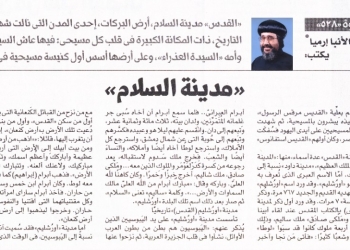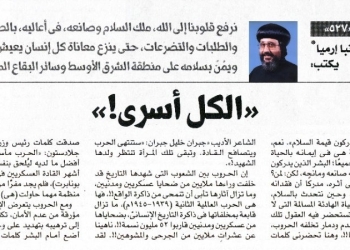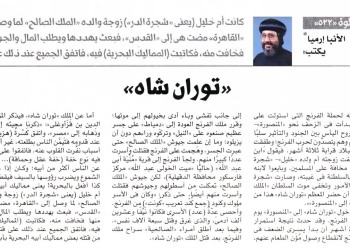In the previous article, we tackled how Amr bin al-‘As described Egypt and Alexandria upon the conquest. Abdullah bin Sa’d bin Abu Sarh became proconsul of Egypt. A revolution broke out in Alexandria. The Roman Emperor sent a fleet led by Manuel to retrieve Egypt, which was yet re-conquered by Amr bin al-‘As on October 645 A.D. Likewise, we spoke of Pope Benjamin I and his caring for the congregation from his return to his departure.
Abdullah bin Sa’d bin Abu Sarh was reassigned the affairs of Egypt after seizing Alexandria and expelling the Romans from it. Historians maintain that the tenth year of his tenure witnessed the first naval battle against the Arabs. That battle took place western Alexandria. It was called the Battle of Masts (the Battle of Phoenix) due to the clash of fleets. Emperor Constans II was defeated. Historians assert that the battle took place in 654-655 A.D. Likewise, 654 A.D. witnessed the beginning of the rebellion of the Arabs of Egypt against caliph Uthman bin Affan.
In 655 A.D., rebellion spread in Basra, Kufa and Egypt. It reached Medina. At that time, Abdullah bin Sa’d bin Abu Sarh, the proconsul of Egypt, went to meet Uthman, handing over the country’s affairs to Uqbah bin Amir. No sooner had Abdullah left, than a rebellion broke out led by Mohammed bin Abu Hudhayfah, ousting Uqbah from Egypt. That rebellion aimed at dethroning caliph Uthman. When this news reached Abdullah, he decided to return, but he could not make it, as the rebels fought him. Thus, he had to retract to Palestine.
On June 17, 656, caliph Uthman was killed for having refused to abdicate. He was succeeded by Ali bin Abu Talib after prophet Mohammed’s associates (al-sahabah) had pledged allegiance to him in Medina. Yet, Umayyads refused to do so, which gave rise to trouble. Arabs were split into factions after Caliph Ali bin Abu Talib had started deposing the proconsuls assigned by Uthman. So, Mu’awiyah bin Abu Sufyan refused to leave the Levant. Thus, dissidence occurred. Moreover, conflicts broke out in Egypt between the faction of Mohammed bin Hudhayfah, who supported the caliph, and that which supported Mu’awiyah who undertook avenging Uthman. Hudhayfah’s faction was victorious until Mu’awiyah arrived, and both agreed upon stopping the fight.
In 657, Ali bin Abu Talib assigned Egypt’s affairs to Qays bin Sa’d bin Ubadah who was able to win Egypt’s support for the caliph, which made Mu’awiyah sense danger. Thus, he created a rift between Sa’d and the caliph, which resulted in the former’s ousting after a few months of his assignment. He was succeeded by Mohammed bin Abu Bakr. Then came al-Athtar al-Nakhli who was poisoned to death before even entering Egypt. During that year, the battle of Siffin occurred, whereby the Iraqi troops, led by the caliph, fought the Levantine troops led by Mu’awiyah. Mu’awiyah’s troops were on the verge of defeat, had it not been for Amr bin al-‘As who advised him to consult the Qoran that blood might be spared. At first, Ali refused to stop fighting, indicating that the whole thing was a treachery. He said, “It is a word of truth by which is intended falsehood.” Yet, most of his supporters agreed to stop fighting, so he complied. During arbitration, Amr bin al-‘As was able to deceive Ali bin Mussa al-Ash’ari by convincing him that both Ali and Mu’awiyah would be deposed and a new caliph would be chosen. Al-Ash’ari implemented the agreement, while Amr deposed Ali and accredited Mu’awiyah.
In 658, Amr was appointed by Mu’awiyah proconsul of Egypt for the second time, after which Mohammed bin Abu Bakr al-Siddiq snatched it from him. In 659, Pope Benjamin, the thirty-eighth patriarch, departed.
In 660, Ali bin Abu Talib was murdered after three of the Khawarij had conspired to murder Ali, Amr and Mu’awiyah. However, they failed to kill Amr and Mu’awiyah. At that time Imam al-Hassan bin Ali succeeded his father in the caliphate. In 661, the nation decided that Mu’awiyah become caliph, which is why that year was called the year of consensus (‘am al-jama’a), after which al-Hassan and Mu’awiyah fought each other. Yet, al-Hassan gave up the caliphate to spare blood.
After the Umayyads had taken over, Amr was reappointed proconsul of Egypt where he remained until his death in 664. At that time, Pope Agathon, had become the thirty-ninth patriarch of St. Mark’s See.
Pope Agathon
Pope Agathon succeeded Pope Benjamin I. He was contemporary to Ali during the last year of his caliphate. He was also contemporary to some Umayyad proconsuls of Egypt. During his papacy, the Copts were given trouble by a Theodosius, a Roman, who went to caliph Yazid bin Mu’awiyah, to deceive him into obtaining a permission to rule Alexandria and Marriott. Theodosius almost killed Pope Agathon. He even told his followers, “If you happen to see the Orthodox Pope at any time, stone him to death. I will be appointed in his stead.” He wanted to be patriarch. It came to pass that after Pope Agathon’s departure in 677, Theodosius shut the doors of the cathedral and sealed them with red wax! Yet, the Copts sought the help of the Muslim ruler of Xois who supported them.
The Umayyad State
Many Umayyad proconsuls ruled Egypt from 662 to 750 A.D. Mu’awiyah bin Abu Sufyan was interested in conquests, especially in North Africa, the coastal areas of Sistan, Khorasan, and Transoxiana (Ma wara’ al-nahr). He was able to retrieve Armenia which the Arabs lost during the sedition (fitna), only to lose it later! Mu’awiyah tried to conquer Constantinople twice, but he could not. He moved the capital of the State from Kufa to Damascus, for it had been moved from Medina to Kufa during Ali’s tenure.
Professor Doctor Hassan Ibrahim Hassan describes that period of time as follows, “Egypt was ruled by many proconsuls during the Umayyad tenure until the advent of the Tulunids in 254 Hijri. Despite the lengthiness of the Umayyad era (about two centuries), Egypt did not develop considerably. This is ascribed to the shortness of the proconsuls’ tenure, the instability of their posts, exaggeration in imposing taxes, and other stories…” Stories never end in Beautiful Egypt.
General Bishop
Head of the Copt Orthodox Cultural Center









